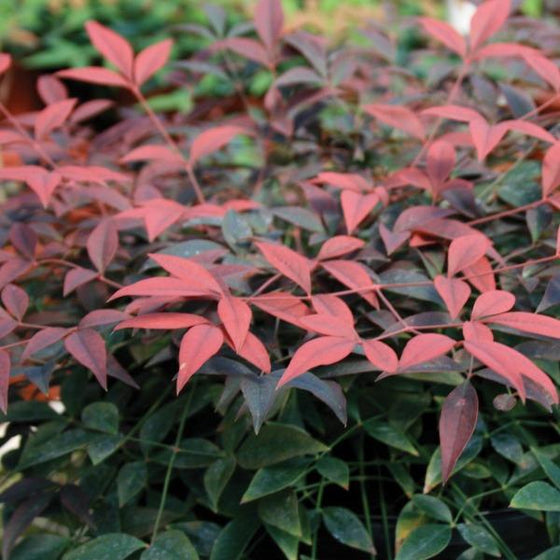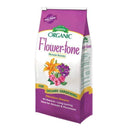
Images Depict Mature Plants
Nandina Flirt Shrubs for Sale Online
Nandina Flirt is an improved version of Nandina Harbour Dwarf and was developed by Southern Living Plants. It features new leaves of bright red that emerge in spring and keep their striking color throughout the year. The compact growth habit of Flirt Nandina makes it a perfect choice for small landscapes because of its tight, dense mounding habit. It is a dwarf cultivar that reaches up to 12-24" tall, with a spread of 12-16". It is a sport of Nandina Harbour Dwarf but differs in having wine red colored young foliage. Mature foliage is deep blue-green.

| Hardiness Zone: | 6-11 |
|---|---|
| Mature Height: | 1 to 2 feet |
| Mature Width: | 1.5 to 2 feet |
| Classification: | Dwarf, Compact,Broad leaved evergreen shrub |
| Sunlight: | Full Sun to Part Shade |
| Habit: | large mounding |
| Foliage: | Deep Red new growth turning Green |
| Flower Color: | White |
| Pruning Season: | Pruning not needed |
| Soil Condition: | Any well drained soil |
| Water Requirements: | Water well until established |
| Uses: | Extremely attractive when used as in the mixed border, or containers |
How to Care for Flirt™ Nandina
Before you purchase your Nandina Flirt shrub, be sure to read the recommended care instructions to ensure your plant lives happy and healthy for years to come!
How Do I Water My Nandina Flirt Shrub?
After backfilling and lightly compacting the 50/50 mix of existing soil and compost, give the Nandina Flirt shrub a deep watering. Most of the water you put on the plant at first will run away from the plant until the soil is soaked. A general rule of thumb is to count to 5 for every one gallon of pot size. For example, a one-gallon pot would be watered until you count to 5, and a three-gallon container would be 15, and so on. Check the plant daily for the first week or so and then every other day. You will want to water the bushes regularly after planting until well established. We like to tell folks that when watering Nandina or any plant, for that matter, it's best not to saturate the foliage of the plant. Water at the base of the plant near the soil line only.
How often should I fertilize my Nandina Flirt Shrub?
Plants such as Nandina Flirt grow best if fertilized once in the spring and again in early summer. Flirt Nandina favors nutrient-rich soil and ample fertilization. We recommend an Organic fertilizer that tends to release nutrients over a long period. An organic method of applying manure and compost around the roots produces excellent results and improves the condition of the soil. Organic additions to the soil can be combined with a shot of chemical fertilizer for maximum effect. If chemical fertilizers are used on your Flirt Nandina, applying a slow-release, balanced fertilizer once a year in the spring is probably the simplest solution. However, slow-release is certainly not the only way to fertilize Nandina shrubs, such as Flirt Nandina. Don't fertilize your Nandina after August In the North. Nandina shrubs begin to prepare for dormancy in the fall. It can stimulate new growth that will be too tender to withstand the winter. In the South, late summer into September application; would be about right. As mentioned, one spring application of a balanced fertilizer should more than suffice. Over-fertilization can be much more detrimental than under-fertilization. It is much, much better to err on the side of too little fertilizer than too much. When roots burn, the first sign is often scorched looking leaves.
How Do I Plant My Flirt Nandina Shrub Successfully?
When planting your newly purchased Flirt Nandina plant, dig a hole twice as wide as the root system but not deeper. Depending on the quality of your existing soil, you may need to add locally sourced compost or topsoil to the back-fill soil. We do not recommend using straight topsoil or compost as a back-fill soil because more times than not, these products will retain entirely too much moisture and will cause the root system to rot. Adding compost or topsoil will help the young feeder roots of Flirt Nandina to spread through the loose, nutrient-rich soil, much easier than if you used solely the existing soil, which more times than not will be hard and compacted. The most common cause of plant death after transplanting is planting the new plant too deep. A good rule is that you should still see the soil the plant was grown in after back-filling the hole. Bio-tone starter fertilizer is a starter fertilizer that provides plants with a mycorrhizal fungus. It is a naturally occurring beneficial fungus that colonizes the new growing roots of plants. It creates a barrier between the roots and fungus and pathogens that can cause root rot.
How Should I Mulch My Nandina Flirt Shrub?
We highly recommend that you mulch your Nandina Flirt shrub with either a ground hardwood mulch or a ground cypress mulch depending on your local availability. Any mulch will do, but cypress or hardwood mulch will be of a higher quality and provide better nutrition overall as they break down. Mulching helps to keep weeds away that will compete with your new investment for water and nutrients. A 2 to 3-inch layer of mulch is sufficient but remember to take care not to cover any part of the stem with mulch. It is better to leave a one-inch gap of space between the mulch and the stem or trunk of the plant.













